|
base level
correlative conformity
distal-fan
forced regression
lowstand systems tract
mid-fan
mid-slope-channels
proximal-fan
toe-of-slope-fan
sequence boundary
systems tract
unconformity
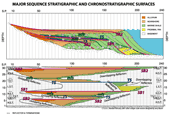

|
This is the seaward or basinward portion of the lowstand systems tract where deeper basins are characterized by the deposition of submarine fans on the lower slope or basin floor. This fan formation is associated with the erosion of canyons into the slope and the incision of fluvial valleys into the shelf. Siliciclastic sediment bypasses the shelf and slope through the valleys and canyons to feed the basin-floor fan. The basin-floor fan may be deposited at the mouth of a canyon or widely separated from it, or a canyon may not be evident. Traced from upslope into the basin the fan has been divided into Mid Slope Channels, Toe of Slope, proximal Fan, Mid Fan and distal Fan (Beaubouef et al., 1999) or their equivalents of Slope Channels, Inner Fan, Mid Fan, Supra-Fan and Basin Plain by this site.
There is some interest in differentiating submarine fans from turbidite systems. Stelting et al (2000) and Menard (1955) define submarine fans are deepwater sediments exposed on the present-day sea floor that accumulated from sediment gravity flows while similar sediments that form consolidated deposits in the subsurface and/or outcrop are defined by Stelting et al (2000) and (Mutti and Normark, 1987, 1991) as turbidite systems. The choice is yours, but after reviewing the literature this site believes that these terms are so widely used for both the recent and the ancient that they have become interchangeable.
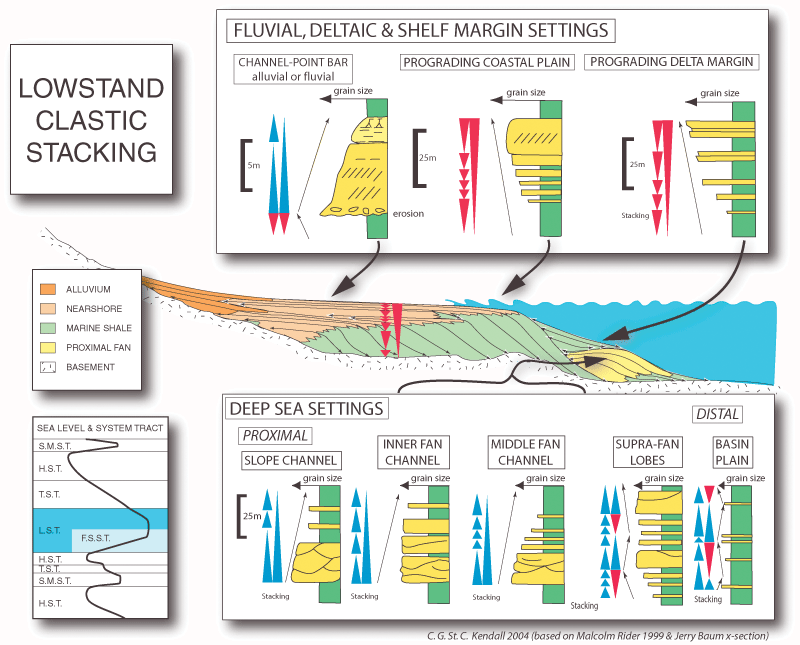
As demonstrated by Hunt and Tucker (1992) the up dip erosion that builds most fan complexes is associated with the base level fall that drives forced regressions of the shoreline. They show how the upper surface of downlapping and prograding shoreline of the forced regression is eroded and is expressed as a diachronous subaerial unconformity. This is Plint and Nummedal's (2000) "regressive surface of fluvial erosion". Hunt and Tucker (1992) match this unconformity to a downdip surface they call the marine correlative conformity that they relate to the end of a base level fall. The resulting sedimentation at the base of the basin margin slope setting produces most basin floor fan systems. In this setting Hunt and Tucker (1992) argue that the correlative conformity can be traced to the top of the prograding submarine fan complex . The Hunt and Tucker (1992) suggest that this "sequence boundary" over the forced regression does not match Mitchum's (1977) original definition of a sequence boundary or its time equivalent marine correlative conformity that was tied to the onset of a sea level fall.
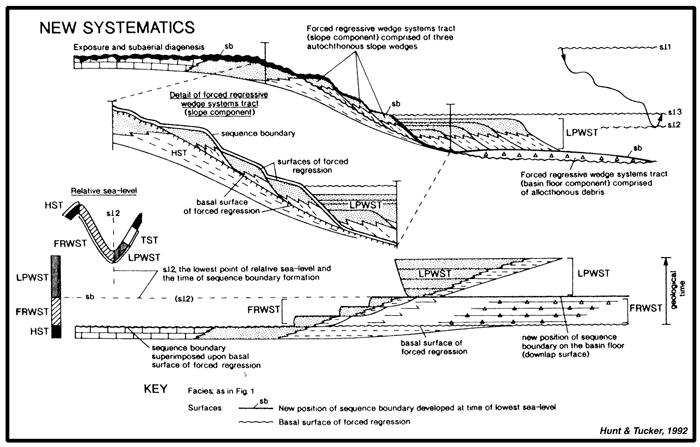
forced regression diagram of Hunt and Tucker (1992)
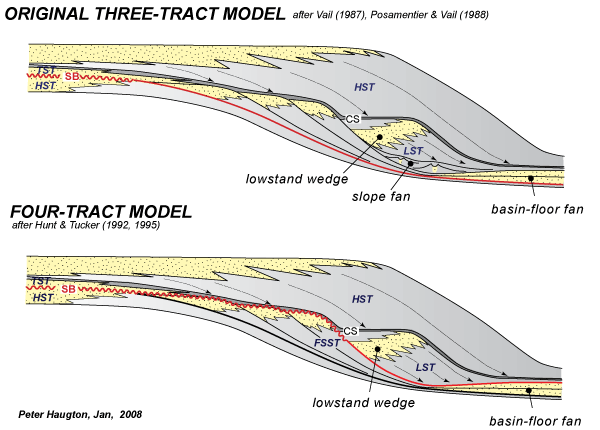
Note the correlative conformity on the top of the basin floor fan as suggested by Vail, 1987, versus the Hunt and Tucker, 1992 & 1995, models.
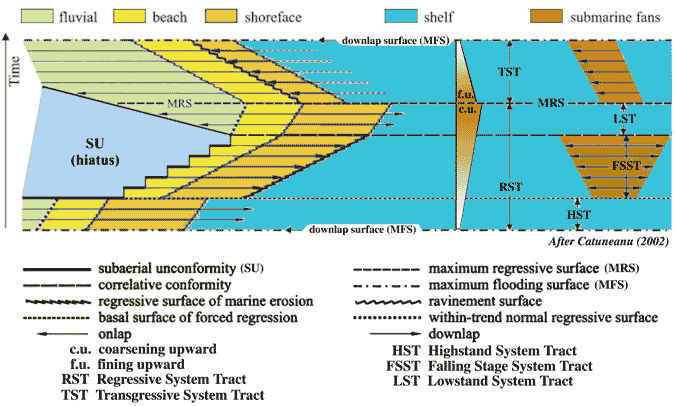
Wheeler diagram with correlative conformity on the top of the basin floor fan
References
Beaubouef, R.T., C.R. Rossen, F.B. Zelt, M.D. Sullivan, D.C. Mohrig, D.C. Jennette, J.A. Bellian, S.J. Friedman, R.W. Lovell, and D.S. Shannon, 1999, Deepwater sandstones, Brushy Canyon formation, West Texas: AAPG Continuing Education Course Note Series, v. 40, pp.48
Catuneanu,O., 2002, sequence stratigraphy of clastic systems: concepts, merits, and pitfalls, Journal of African Earth Sciences, Volume 35, Issue 1, Pages 1-43
Hunt, D., Tucker, M.E., 1992, Stranded parasequences and the forced regressive wedge systems tract: deposition during base-level fall. Sedimentary Geology 81, 1–9.
Menard, H. W., 1955, Deep-sea channels, topography, and sedimentation: AAPG Bulletin, v. 39, p. 236–255.
Mitchum Jr., R.M., 1977, Seismic stratigraphy and global changes of sea level. Part 11: glossary of terms used in seismic stratigraphy. In: Payton, C.E. (Ed.), Seismic stratigraphy––Applications to Hydrocarbon Exploration, vol. 26. A.A.P.G. Memoir, pp. 205–212.
Mutti, E., and W. R. Normark, 1987, Comparing examples of modern and ancient turbidite systems: problems and concepts, in J. K. Leggett and G. G. Zuffa, eds., Marine clastic sedimentology: concepts and case studies: London, Graham and Troutman, p. 1–38.
Mutti, E., and W. R. Normark, 1991, An integrated approach to the study of turbidite systems, in P. Weimer, and M. H. Link, eds., Seismic facies and sedimentary processes of submarine fans and turbidite systems: New York, Springer-Verlag, p. 75–106.
Plint, A.G., Nummedal, D., 2000, The falling stage systems tract: recognition and importance in sequence stratigraphic analysis. In: Hunt, D., Gawthorpe, R.L. (Eds.), Sedimentary Response to forced regression, vol. 172. Geol. Soc. London Speci. Publ, pp. 1–17.
Stelting, C.E., A.H. Bouma, and C.G. Stone, 2000, Fine-Grained turbidite Systems: Overview, in Fine-Grained turbidite Systems/edited by A. H. Bouma and C. G. Stone. AAPG Memoir 72, SEPM Special Publication No. 68., p1-8
|